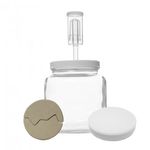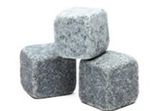Goal of Food Preservation: Increase Shelf-life of Food and Keep Food Safe - University of Illinois ...
←
→
Page content transcription
If your browser does not render page correctly, please read the page content below
Goal of Food Preservation: Increase Shelf-life of Food and Keep Food Safe
Selecting Produce
Fermentation is simply the process in which a substance breaks down into simpler components.
Microorganisms like yeast, bacteria and mold play a role in the fermentation process, creating foods and
drinks such as beer, wine, sourdough bread, sauerkraut, kimchi, yogurt, chocolate, pickles, tempeh, koji and
miso. Fermentation has been used for thousands of years to preserve food and is seeing a revival as people
learn to ferment their own foods and beverages. This is a safe, easy and economical way to preserve food.
Whether you want to keep alive old traditions, create probiotic-rich foods or simply experiment with new
flavors, food fermentation will prove to be a rewarding endeavor.
Lacto-Fermentation
To dispel a common myth about lacto-fermentation, it doesn't necessarily have anything to do with dairy as
some relate “lacto” to the lactose (sugar) found in milk. Instead, the “lacto” refers to lactic acid that’s
produced during the fermentation process by lactic-acid producing bacteria which are present on the surface of
all fruits and vegetables. In an anaerobic (oxygen-free) environment, these bacteria convert sugars into lactic
acid, which inhibits harmful bacteria and acts as a preservative. It's also what gives fermented foods their
characteristic sour flavor
The natural acids and other antimicrobial compounds produced by the fermenting bacteria inhibit the growth
of other harmful bacteria, molds and yeasts that contribute to spoilage. Additionally, the carbon dioxide
produced during the fermentation process helps maintain the low-oxygen conditions necessary for the
fermenting bacteria to flourish. Carbon dioxide also aids in the stabilization of flavor and color.
Of the many groups of fermenting bacteria, those from the lactic acid bacteria family are the most important in
vegetable fermentation – specifically Leuconostoc, Lactobacillus and Pediococcus species.
Benefits
1. Enhanced digestibility due to enzyme action
2. Increased vitamin levels, specifically B vitamins and preservation of
vitamins A and C
3. Improved gut health due to presence of probiotics
Keep in mind that not all fermented foods you buy in the store will contain
live probiotics. Check the label for “Live Active Cultures”.
University of Illinois-Champaign College of Agriculture, Consumer and Environmental Sciences. United States Department of Agriculture/Local
Extension Councils Cooperating. University of Illinois Extension provides equal opportunities in programs and employmentFiltered water or spring water are preferred. Tap water usually contains chlorine,
chloramines and fluoride that must be removed before culturing.
If using bottled water, check the source to be sure it is free of chemicals.
Do not use distilled water.
Well water can be used but have it tested for contaminants prior to use.
The salt used in fermentation should contain no additives. Canning or pickling salt
is recommended since it contains no impurities and has a consistent granular size
and weight.
Generally 5% salt concentrations are used for large vegetables (cucumbers and
carrots) and a 3% concentration is used for shredded vegetables (cabbage).
Brine Calculation
Functions of salt in the fermentation process: Added to 1 quart of water:
Allows needed water and sugars to be pulled from 3% = 2 tablespoons of salt (1 ounce or 27 grams)
the vegetables 5% = 3 tablespoons of salt (1.6 ounce or 45 grams)
Aids in the growth of fermenting bacteria over *It is best to weigh salt for accuracy.
spoilage bacteria, yeasts and molds
Allows for crisper vegetables by hardening the plant pectin and decreases the activity of pectinase, an
enzyme that makes vegetables mushy
Allows for longer fermentation by slowing the fermentation process and decreasing the chance of
undesirable mold growth
Gives flavor to the final product
Dry Salting Brining
Salt is added directly to the vegetables. After mixing Mixing salt and water to form brine before adding
in the salt, you may want to leave the mixture for to the vegetables. This technique can allow for
20-30 minutes to allow for natural juice extraction. better coverage of the vegetables which lessens the
Massaging the vegetables helps to speed up the risk of fermentation failure and is best for whole or
process and is a fantastic workout for your hand quartered pieces.
muscles! This step in the process usually takes 10-15 If there isn’t enough brine to cover the vegetables
minutes to get enough liquid pulled out to cover the from dry salting, make your own.
vegetables in the fermentation vessel. Brine = 1 quart water + 1.5 tbsp of salt
University of Illinois-Champaign College of Agriculture, Consumer and Environmental Sciences. United States Department of Agriculture/Local
Extension Councils Cooperating. University of Illinois Extension provides equal opportunities in programs and employmentTools and Equipment
Your container, equipment and food contact surfaces should be washed with hot soapy water before you begin.
Sanitizing is another crucial step. If chlorine bleach is used, the equipment Sanitizing methods
should be rinsed thoroughly to remove any residues which may inhibit the Boil for 10 minutes
growth of fermenting bacteria. See box for more sanitizing options. Oven for 2 hours, at 320°F
Sanitizers made for food/
Cutting, chopping and pounding tools aid in the extr action of the beverage production
vegetable juices necessary to cover the fermenting mixture. What you will
need when it comes to chopping and cutting will depend upon what your
desired final product will be. Kraut boards, food processors, sharp knives, and
mandolins all work well.
Crushers, pestles and sauerkraut pounders break the vegetable tissue, allowing
more juices to be released. Clean hands or gloved hands will also get the job
done. You may need to massage the shredded vegetables for 10-15 minutes
until you have extracted enough liquid to cover the vegetables once transferred to your vessel.
Vessels/Containers
General Rule: 1-gallon container for 5 pounds of fresh vegetables
Use food-grade containers such as glass or plastic (BPA free)
Quart-size glass jars with airlock lids are great for small batches
Do not use copper, iron, or galvanized metal containers or lead-glazed crocks
High-grade, commercial stainless steel can be used
If you are unsure about the safety of a container, err on the side of caution to avoid
harmful materials leaching into your food.
Use of plastic jar lids is advisable since metal lids will degrade under acidic and salty conditions.
Keeping Vegetables (and other foods) Submerged
This is a critical step to the safety and quality of the finished product. Your fermenting product should be kept
1-2 inches below the brine. There are several options to aid in this:
Ceramic weights
Tempered glass weights
Food grade bag filled with brine
Glass or pie plate in addition to the brine filled bag
Whiskey stones are good for smaller vessels (do not confuse with rocks)
A cabbage leaf can help prevent floaters, a brine-filled bag can serve as the weight
University of Illinois-Champaign College of Agriculture, Consumer and Environmental Sciences. United States Department of Agriculture/Local
Extension Councils Cooperating. University of Illinois Extension provides equal opportunities in programs and employmentControlling for Mold 1.Use a jar with an airlock lid
Submerge vegetables 1-2 inches below juice/brine mixture to 2.Keep food submerged below the brine level
prevent spoilage. Exposure to oxygen can encourage and allow
for both mold and yeast to grow. It is critical for vegetables to 3.Control room temperature– ideal=68-72°F
remain submerged during the fermentation process to prevent
4.Use the freshest produce possible
spoilage. The box on the right as additional tips.
5.Use the correct amount of salt
When in Doubt—Throw it Out
6.Clean and sanitize equipment; wash hands
If fermented product is slimy, smells spoiled/rotten, discard it.
and surfaces often
Clean the container thoroughly and try again!
Moving to Cold Storage
Three helpful signs to look for to know when your product is ready for cold storage.
Bubbling- Fer mented pr oducts should have bubbles in the br ine mixtur e. This is because Lactic acid
bacteria produce gases and this shows up in the form of bubbles.
Aroma- The fer mented pr oduct should have a pleasant yet slightly sour ar oma. If it smells spoiled or
rotten, discard it.
Taste- Depending on the type of vegetables used, ther e will be var ying r anges of fer mented flavor s.
Generally, if you want a less sour product, use a shorter fermentation time; longer for more tang. Refer to your
recipe for specifics. Expect subtle changes in flavor even during refrigeration (the process slowly continues).
References
•Vegetable Fermentation., Joell A. Eifert, Food Safety Extension Agent, Virginia Cooperative Extension, Renee R. Boyer, Associ-
ate Professor, Food Science and Technology, Virginia Tech, Robert C. Williams, Associate Professor, Food Science and Technol-
ogy, Susan S. Sumner, Associate Dean Academic Programs, College of Agriculture and Life Sciences
•Breidt, F., McFeeters R. F., Perez-Diaz I., and Lee C. 2013. Food Fermented Vegetables Microbiology: Fundamentals and Fron-
tiers, 4th Ed. Edited by M. P. Doyle and R. L. Buchanan: ASM Press, Washington, D.C.
•USDA. 2009. USDA Complete Guide to Home Canning. U.S. Department of Agriculture National Institute of Food and Agricul-
ture. Agriculture Information Bulletin No. 539.
Additional Food Preservation Resources
Additional Resources
Created by: Kristin Bogdonas, MPH
So Easy to Preserve, 6th Edition University of Illinois Extension Educator, Nutrition & Wellness
Complete Book of Home Preserving Serving Henry, Mercer, Rock Island and Stark Counties
The Ball Blue Book June 2020
National Center for Home Food Preservation
YouTube: What’s Cooking with Mary Liz Wright
From Garden Gates to Dinner Plates: https://
web.extension.illinois.edu/cottage/taskforce.cfm
University of Illinois Extension Food Preservation
Resources: https://web.extension.illinois.edu/
foodpreservation/
University of Illinois-Champaign College of Agriculture, Consumer and Environmental Sciences. United States Department of Agriculture/Local
Extension Councils Cooperating. University of Illinois Extension provides equal opportunities in programs and employmentYou can also read


























































